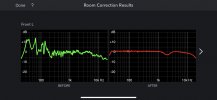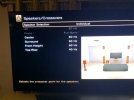My receiver is Marantz SR6013. I had purchased the Audyssey app a long time ago, but had run an Audyssey set up using the app only a few days back.
After the Audyssey set up through the app, to my complete, but pleasant astonishment, Audyssey has transformed my entire HT rig. Now, the scale, the attack, the intensity of movies are far superior than earlier when I had set up Audyssey without the app. See the before and after FR curves below. In the before curve, there are dips in the very uneven frequency response, which I presume was the main reason for an underwhelming HT performance earlier. The after FR curve with the app is almost table top flat.
Does this mean that the Audyssey app is far superior than the stock one on the AV receiver? This means an additional expense to optimise your HT rig. Would like hear if you have had a similar experience with the Audyssey app.
My speakers are MA Silver, with Klipsch 15 inch sub.

After the Audyssey set up through the app, to my complete, but pleasant astonishment, Audyssey has transformed my entire HT rig. Now, the scale, the attack, the intensity of movies are far superior than earlier when I had set up Audyssey without the app. See the before and after FR curves below. In the before curve, there are dips in the very uneven frequency response, which I presume was the main reason for an underwhelming HT performance earlier. The after FR curve with the app is almost table top flat.
Does this mean that the Audyssey app is far superior than the stock one on the AV receiver? This means an additional expense to optimise your HT rig. Would like hear if you have had a similar experience with the Audyssey app.
My speakers are MA Silver, with Klipsch 15 inch sub.



